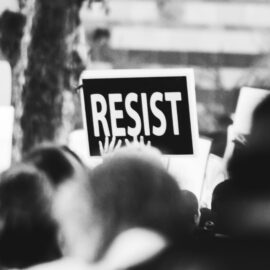
Do you know how to deal with conflict in a marriage? What should you do when you disagree with your spouse or have hurt feelings?
To deal with conflict in a marriage healthily, you need to focus on regulating your own emotions and self-soothing so that you can react in a constructive way with your spouse. It’s also important that you listen to your partner, especially before offering advice and solutions.
Here’s what you can do to handle disagreements in a healthy way.
How to Handle Conflict in a Relationship
Once you move past the sex-addled honeymoon phase of a relationship, conflicts are bound to arise. Conflicts can damage a marriage if couples resort to coping mechanisms like criticism, defensiveness, contempt, or stonewalling. However, knowing how to deal with conflict in a marriage effectively is a powerful way to strengthen your relationship.
| The Four Horsemen of the Apocalypse in Relationships In The Seven Principles for Making Marriage Work, John and Julie Gottman elaborate on how poor conflict management can degrade a marriage over time. They use the metaphor of the Four Horsemen of the Apocalypse from the biblical Book of Revelation to describe four negative communication styles that can cause serious harm to a relationship. These four horsemen are criticism, contempt, defensiveness, and stonewalling. 1. Criticism: This isn’t just voicing a complaint or critique, which focus on specific instances or actions. Criticism, as per the Gottmans’ definition, involves attacking your partner’s personality or character, usually with the intent of making someone right and someone wrong. It often includes blame and generalizations (such as “you always…” or “you never…”). 2. Contempt: This is when one person feels superior to others. It includes sarcasm, cynicism, sneering, mockery, and eye-rolling. Contempt is destructive to a relationship because it makes the other person feel despised and worthless. This horseman is considered the most harmful one as it conveys disgust and disrespect. 3. Defensiveness: This horseman often enters when criticism and contempt have been present. Instead of addressing the issue, the defensive partner redirects the focus onto themselves, behaving as if they are the victim. Defensiveness also escalates conflict rather than resolving it, as it justifies your own actions and blames the problem on your partner. 4. Stonewalling: This horseman arrives when a person withdraws from the interaction, shutting down and closing themselves off from their partner. This typically happens as a response to feeling physiologically overwhelmed, and it often takes the form of looking away, silence, monosyllabic answers, changing the subject, or physically leaving the situation without explanation. When one partner goes into stonewalling mode, it can make the other partner feel ignored or abandoned, further escalating the conflict. |
1. Regulate Your Emotions
Pay attention to your physiological response during conflicts. Men especially often experience a state of emotional flooding when in conflict, characterized by a need to defend, an emotional shutdown, and an inability to self-soothe. In fact, research shows that men tend to become more overwhelmed than women in conflict situations.
If you feel overwhelmed in a conflict, try using self-soothing techniques such as deep breathing or taking a break from the conversation. However, you should communicate your need for this break to your partner to avoid them feeling abandoned or rejected. You can do this by explaining that you’re feeling overwhelmed and making a plan for when you’ll come back together to finish the conversation.
| How Your Attachment Style Impacts Your Response to Conflict In Attached, Amir Levine and Rachel Heller contend that individual responses to conflict, such as emotional flooding, align more closely with one’s attachment style—be it secure, anxious, or avoidant—than with their gender. For example, an avoidant individual may seem distant or defensive, not due to an innate inability to cope with conflict, but as a mechanism to maintain self-reliance and emotional distance. Understanding these attachment-driven behaviors provides a framework that transcends gender stereotypes, suggesting that both men and women can exhibit a range of responses based on their attachment histories. Levine and Heller add that if you become emotionally flooded, communicating your need for a break is especially important if your partner has an insecure attachment style. An insecure attachment style—whether anxious or avoidant—can make a partner particularly sensitive to breaks in communication during a conflict. By explicitly affirming your commitment to the relationship and setting a concrete time to continue the conversation, you help mitigate any fears of abandonment your partner might have. This transparent approach honors your need for emotional regulation but also considers your partner’s attachment needs. |
2. Listen and Ask Questions
When a woman brings a problem to a man’s attention, it’s often a bid for connection rather than a desire for immediate problem-solving. She wants to be heard and understood. Rather than viewing conflict as a problem to be solved, you can approach the situation with curiosity. Ask open-ended questions to better understand your partner’s perspective, feelings, concerns, and needs. This active listening approach can go a long way in resolving conflicts and strengthening your connection.
(Shortform note: Sometimes physical touch is enough to show your partner you’re listening. Researchers have found that showing physical affection during conflict can help couples manage disagreements more effectively because it reduces stress, increases empathy, and makes partners feel closer. In one study, couples who held hands during a tense discussion not only reported feeling less stress during the conversation but also engaged in more constructive conflict behaviors. However, for couples struggling with serious ongoing issues, physical touch can also be interpreted negatively, particularly if it’s seen as a tool of control or manipulation.)
Exercise: Rethink Conflict
Conflicts are a part of any long-term relationship, but the conflict matters less than how you handle it.
- Describe a conflict you’ve had recently that’s unresolved.
- What was your immediate emotional reaction to the conflict? Reflect on how this emotion might have influenced your actions or words during the conflict.
- The next time you’re in disagreement with someone you love, what do you want to do differently (for example, take a break to de-escalate, start by asking questions, or validate their feelings)?






